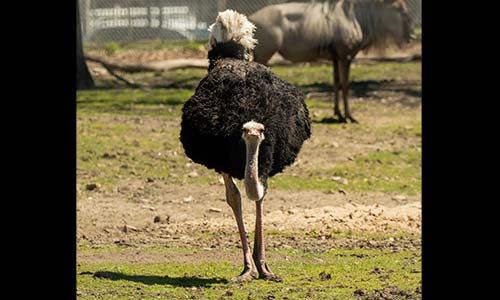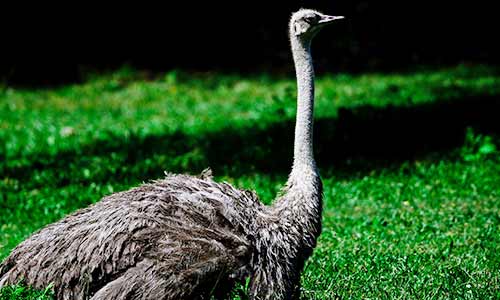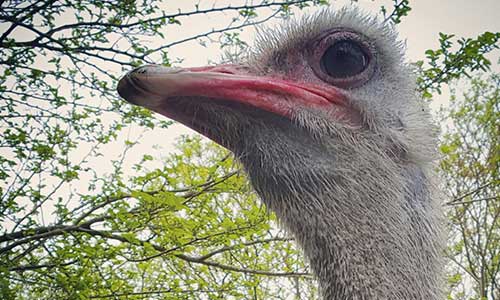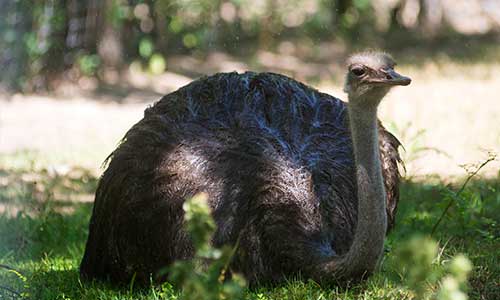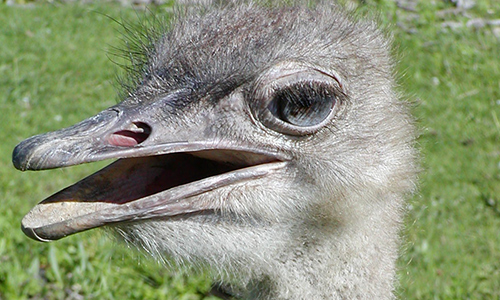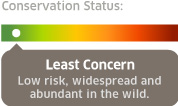Appearance:
Ostriches are flightless birds built for running. They use their wings for balance as they run. Their long powerful legs, flexible knees, and two-toed feet help them outrun predators, maintain speed over long distances, and increase agility. Their legs can deliver powerful kicks in self-defense, and each of their toes has a long, sharp claw. They can reach speeds of 45 miles per hour, making them the world’s fastest two-legged animal. Ostriches also have three stomachs.
Males are black with white primary flight feathers and tail. Females are gray-brown and white. Females tend to have pink-gray skin while males have gray, blue-gray, or pink skin. The beak is flat and broad with a rounded tip. Their necks are long, and their feathers are surprisingly soft. Ostriches lack the special gland many birds have to waterproof their feathers while preening, so their feathers can get soaked in the rain. At nearly two inches across, ostrich eyes are the largest of any land animal. Their eyes are almost on the side of their heads, giving them a 350-degree view of their environment.
Size:
Ostriches are the largest and heaviest living bird.
Wing span: reaches 6-7 feet
Males: approximately 350 pounds and 8 feet tall
Females: approximately 220 pounds and 6 feet tall
Diet:
Ostriches eat mostly roots, seeds, and plants but will also eat lizards, insects, and other small creatures if necessary. Since they lack teeth, ostriches swallow pebbles, sand and small stones to grind up food in their gizzard.
Mating and Reproduction:
A territorial male hisses to claim between two and seven females. Though he may breed with all of them, he will only pair bond with the dominant female. He performs for potential mates using alternating wing beats. They graze until their beat pattern is synchronized. The male pecks at the ground and violently flaps his wings, clearing a space on the ground for the nest. After the male runs in circles, the female drops to the ground, and mating proceeds.
Ostriches reach sexual maturity between ages 2 and 4, with females maturing six months before males. Mating season begins in March or April and ends in September. Females lay eggs in communal nests, using their feather colors for camouflage. Eggs are incubated for 35 to 45 days, females incubating by day and males by night. Eggs are extremely strong; a male can even stand on one without breaking it. Once hatched, the male ostrich teaches babies to feed. During their first year of life, ostriches grow about 10 inches per month.
Behavior:
With acute eyesight and hearing, ostriches can sense predators from long distances. When threatened, their powerful legs and kicks serve as strong defenses. These birds tend to live in nomadic groups of five to 50, but during the winter months they live either in pairs or alone.
Contrary to popular belief, ostriches don’t bury their heads in the sand. Instead, ostriches dig deep holes in the dirt for their eggs. When they lean down to turn the eggs with their beak, it looks as if their head is buried in the sand.
Habitat/Range:
Ostriches live in the grasslands of East Africa, South Africa, and in the Sahara and Sahel area. This includes the countries of Angola, Botswana, Burkina Faso, Cameroon, Central African Republic, Chad, Djibouti, Egypt, Eritrea, Ethiopia, Kenya, Libya, Mali, Mauritania, Mozambique, Namibia, Niger, Nigeria, Senegal, Somalia, South Africa, South Sudan, Sudan, Tanzania, Uganda, Western Sahara, Zambia and Zimbabwe.
Role in Habitat:
They are major prey for cheetahs, hyenas, leopards and other large savannah predators. Young fall prey to large birds of prey and jackals.
Life Expectancy:
Average 11 years
Fun Fact:
Why do you think one bird has mostly black body feathers and the other mostly grey? Males and females take turns incubating their eggs. The darkness of the night hides the male, while the female blends into her surroundings during the day. Sharing the nest duty in this way protects eggs from predators.


